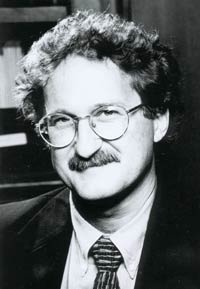UC Berkeley Press Release
Modern slavery thriving in the U.S.
BERKELEY – Washington, D.C. - A new report on forced labor in the United States reveals in disturbing detail how individuals in communities across the country are forced through threats or violence to work in deplorable conditions for little or no pay.
The report, "Hidden Slaves: Forced Labor in the United States," describes for the first time the nature and scope of modern-day slavery in America.
Released during a news conference in Washington, D.C., today (Thursday, Sept. 23), the report was conducted by researchers from the University of California, Berkeley's Human Rights Center and the Washington D.C.-based, anti-slavery group Free the Slaves.
 Laurel Fletcher (Jim Block photo) |
Forced labor occurs in at least 90 cities across the United States, the researchers found, and at any given time, 10,000 or more people are forced to toil in sweat shops, clean homes, labor on farms, or work as prostitutes or strippers.
"The most shocking aspect of this report is that modern-day slavery still exists," said Laurel Fletcher, a researcher at the Human Rights Center and professor at UC Berkeley's law school. "Slavery is a problem the public thinks we solved long ago, but, in fact, it's alive and well. It has simply taken on a new form."
And the form of slavery will continue to change, said Kevin Bales, president of Free the Slaves. "It is important to remember that slavery is a crime and that criminals are always looking for new ways to exploit people."
Cases documented in the report include a Berkeley, Calif., businessman who enslaved young girls and women for sex and to work in his restaurant; a Florida employer who threatened violence to force hundreds of Mexican and Guatemalan workers to harvest fruit; and two couples in Washington, D.C., who brought Cameroonian teenagers to the United States with the promise of a better education and then forced them to work 14 hours a day as domestic servants, without pay and under the threat of deportation.
Among the report's major findings:
* While forced labor exists across the United States, reported cases are concentrated in states with large immigrant communities, including California, Florida, New York and Texas.
* Victims of forced labor are trafficked into the United States from at least 38 different countries, with China, Mexico and Vietnam topping the list. Some are born in the United States and later held captive.
* Forced labor occurs in poorly regulated industries with a high demand for cheap labor - sweatshops, restaurants and hotels, in addition to agriculture and domestic work. A lack of official monitoring in these areas means unscrupulous employers and criminal networks can gain complete control over workers.
* Forty-six percent of those trapped in forced labor in America are found in prostitution and sex services, the study estimates. Another 27 percent are domestic workers, and one in 10 works in agriculture. These victims are spread across the economy - sweatshop/factory work makes up 5 percent; restaurant and hotel work makes up 4 percent. Sexual exploitation of children represents 3 percent.
The new study documents how modern slavery operates in the United States. Perpetrators use a range of crimes - fraud, coercion, physical and psychological violence - to hold their victims captive. They confiscate passports and threaten to turn their captives over to the authorities if they refuse to obey. In some cases, perpetrators and their associates threaten or physically attack the families of victims in their home countries.
 Eric Stover (Jane Scherr photo) |
"Victims may be verbally abused, beaten or sexually assaulted by their captors," said Eric Stover, director of the Human Rights Center and faculty member at UC Berkeley's School of Public Health. "These repeated attacks, especially against children and teenagers, can result in serious physical and psychological trauma."
Even if victims can escape, they often fear leaving because they do not speak English, are unfamiliar with U.S. currency, and are unsure of how to use local transport.
In a strange land, victims can grow dependent on their captors, if only to survive.
According to Bales, "The lack of public awareness of slavery in America makes this report very important. People are literally living next door to slaves without knowing it."
New federal laws have been passed to combat these crimes, but the researchers found that much more needs to be done - especially at the local level. Police officers, rather than federal agents, are most likely to encounter forced labor but often mistake it for illegal immigration and treat victims as part of a criminal enterprise.
The researchers recommend launching a broad-based public awareness campaign; improving monitoring of industries vulnerable to forced labor; increasing training and coordination among law enforcement officials in the United States; and strengthening protections for survivors of forced labor.
The study was conducted by researchers from Free the Slaves and from the Human Rights Center, which collaborates closely with the International Human Rights Law Clinic at the UC Berkeley School of Law (Boalt Hall). Florida State University's Center for the Advancement of Human Rights also assisted with the research.
The report covers the period of 1998 to 2003 and is based on quantitative and qualitative data, including a survey of 49 service providers experienced in forced labor cases; an analysis of 131 cases of forced labor reported in U.S. newspapers; eight case studies of forced labor in various regions of the United States; and interviews with government officials, service providers and labor advocates. Copies of the "Hidden Slaves" report will be available online at: www.hrcberkeley.org and www.freetheslaves.net.

